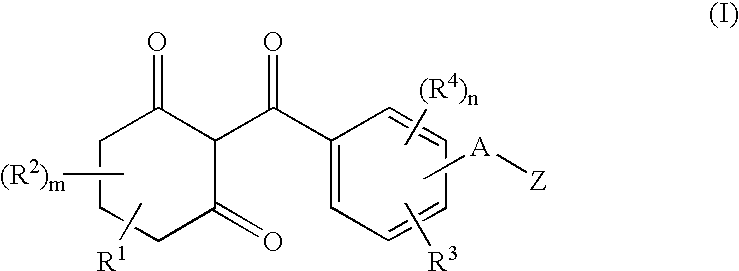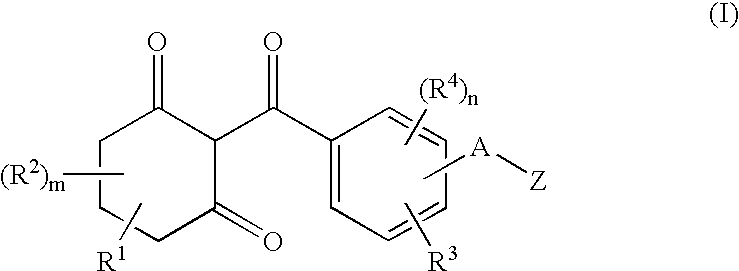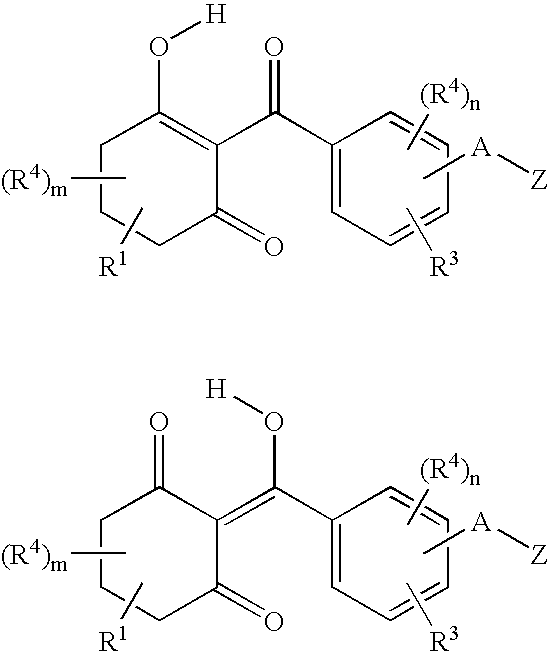Substituted benzoylcyclohexandiones
a technology of benzoylcyclohexanediones and substituted benzoylcyclohexanediones, which is applied in the field of substitution of benzoylcyclohexanediones, can solve the problems that the activity of these compounds is not in all respects satisfactory
- Summary
- Abstract
- Description
- Claims
- Application Information
AI Technical Summary
Benefits of technology
Problems solved by technology
Method used
Image
Examples
example 1
[0130]
1.2 g (3.48 mmol) of 5-ethoxy-4-methyl-2-(2-carboxy-5-trifluoromethyl-benzyl)-2,4-dihydro-3H-1,2,4-triazol-3-one are suspended in 30 ml of acetonitrile and, at room temperature (approximately 20° C.), admixed with 0.39 g (3.48 mmol) of 1,3-cyclohexanedione and 0.76 g (3.7 mmol) of dicyclohexylcarbodiimide (DCC). The reaction mixture is stirred at room temperature overnight (approximately 15 hours) and then admixed with 1.0 ml (7.0 mmol) of triethylamine and 0.10 ml (1.39 mmol) of trimethylsilyl cyanide. After 3 hours at room temperature, the mixture is stirred with 100 ml of 5% strength aqueous sodium carbonate solution, the dicyclohexylurea that separates out is filtered off with suction and the alkaline aqueous phase is repeatedly extracted with ethyl acetate. The aqueous phase is then adjusted to pH 2 using 35% strength hydrochloric acid and extracted repeatedly with methylene chloride. The methylene chloride phases are dried over sodium sulphate and concentrated.
[0131]This...
example 2
[0133]
[0134]A solution of 1.5 g (7.2 mmol) of dicyclohexylcarbodiimide in 40 ml of acetonitrile is added to a suspension of 2.15 g (6.5 mmol) of 2-(4-carboxy-3-chloro-phenyl)-4-methyl-5-trifluoromethyl-2,4-dihydro-3H-1,2,4-triazol-3-one, 0.83 g (7.2 mmol) of 1,3-cyclohexanedione and 40 ml of acetonitrile, and the reaction mixture is stirred at 20° C. for 16 hours. 1.3 g (13 mmol) of triethylamine and 0.26 g (2.6 mmol) of trimethylsilyl cyanide are then added, and the reaction mixture is stirred at 20° C. for a further 4 hours. The mixture is then stirred with 180 ml of 2% strength aqueous sodium carbonate solution and filtered off with suction. The mother liquor is extracted with ethyl acetate. The aqueous phase is then acidified using 2N hydrochloric acid and extracted with methylene chloride. The organic phase is dried, concentrated under water pump vacuum and digested with diethyl ether / petroleum ether. The resulting crystalline product is isolated by filtration with suction.
[013...
example
(IV-2)
[0160]
[0161]6.7 g (40 mmol) of 4-methyl-5-trifluoromethyl-2,4-dihydro-3H-1,2,4-triazol-3-one are initially charged in 150 ml of acetonitrile and admixed with 11 g (80 mmol) of potassium carbonate. The mixture is heated to 50° C., and a solution of 13.1 g (44 mmol) of methyl 3-bromomethyl-2,4-dichloro-benzoate in 20 ml of acetonitrile is then added dropwise with stirring, and the reaction mixture is heated under reflux with stirring for another 15 hours. The mixture is subsequently concentrated under water pump vacuum, and the residue is taken up in methylene chloride, washed with 1N hydrochloric acid, dried with sodium sulphate and filtered. The filtrate is concentrated under reduced pressure, the residue is digested with petroleum ether and the crystalline product is isolated by filtration with suction.
[0162]This gives 14.9 g (97% of theory) of 4-methyl-5-trifluoromethyl-2-(2,6-dichloro-3-methoxycarbonyl-benzyl)-2,4-dihydro-3H-1.2.4-triazol-3-one of melting point 109° C.
[0163...
PUM
| Property | Measurement | Unit |
|---|---|---|
| temperatures | aaaaa | aaaaa |
| temperatures | aaaaa | aaaaa |
| temperatures | aaaaa | aaaaa |
Abstract
Description
Claims
Application Information
 Login to View More
Login to View More - R&D
- Intellectual Property
- Life Sciences
- Materials
- Tech Scout
- Unparalleled Data Quality
- Higher Quality Content
- 60% Fewer Hallucinations
Browse by: Latest US Patents, China's latest patents, Technical Efficacy Thesaurus, Application Domain, Technology Topic, Popular Technical Reports.
© 2025 PatSnap. All rights reserved.Legal|Privacy policy|Modern Slavery Act Transparency Statement|Sitemap|About US| Contact US: help@patsnap.com



